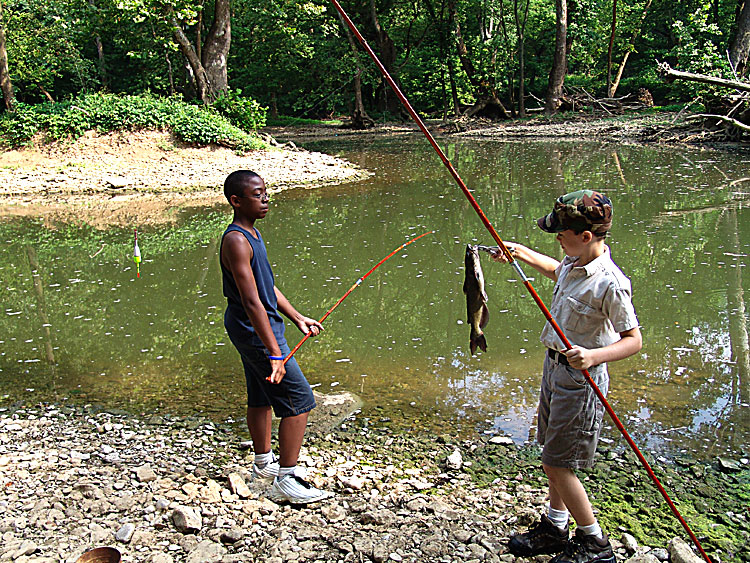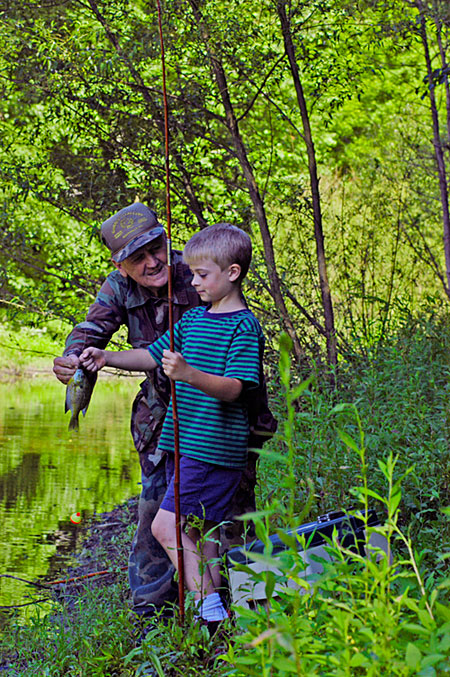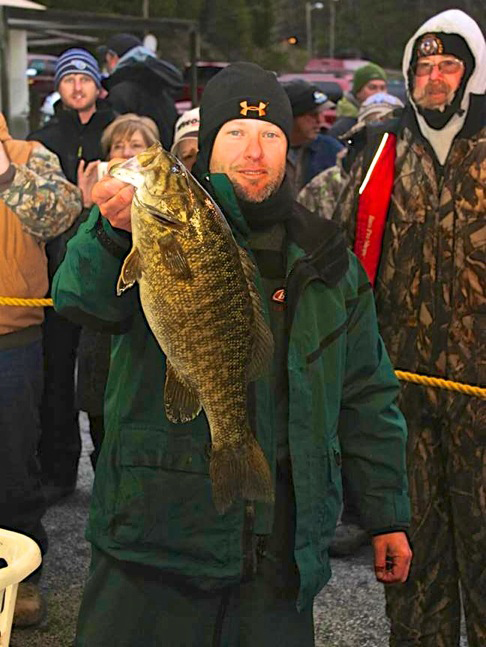May 26, 2011 Contact: Art Lander, Jr. 1-800-858-1549, ext. 4414
Author Art Lander
FRANKFORT, Ky. – With Kentucky’s free fishing weekend fast approaching, now’s the time to get your fishing tackle ready.

During June 4-5, anyone can fish for free in Kentucky without having a fishing license. It doesn’t matter whether you live in Kentucky or are just visiting the state.
If you don’t know much about how to fish, remember that simplicity is best. For most panfish angling, a cane pole or telescopic fiberglass fishing pole is ideal. These are fishing poles that you tie line to the tip – no reels required.
Although these poles may exceed 8 feet in length, fiberglass poles can be collapsed into a shorter length and stored in a car trunk. Most cane poles, too, can be broken down into sections for transport.
These lightweight poles can be easily handled by the smallest of youngsters, with only minimal assistance from an adult.

Bluegill, present in most ponds, lakes, and streams across the state, are eager feeders and big fun on light tackle. Look for them around submerged cover, such as sunken bushes, tree roots, docks or weeds in the water.
The basic rig for bluegills is a BB-size split shot sinker, a small plastic or wooden float and a long-shank, light wire hook. A good all-around line for most fishing is 8-pound monofilament. The poundage refers to the breaking strength of the line.
Use No. 8 or No. 10 hooks for bluegill. The number indicates the size of the hook, and is marked on the package. A hook with a long shank makes it easier to dislodge the hook if the fish swallows the bait. Small needle-nosed pliers or hemostats come in handy for unhooking fish; fingernail clippers worn around the neck on a lanyard make quick work of cutting line.
It’s hard to beat red worms for catching bluegills, although meal worms and crickets are also good baits. These are available at bait shops or some large retail stores with sporting goods departments.
Looking for a place to fish? There’s probably a public lake ideal for fishing from the banks near where you live.
Fishery biologist Dane Balsman, who manages the Fishing in Neighborhoods (FINS) program for the Kentucky Department of Fish and Wildlife Resources, said employees have been busy preparing lakes for the free fishing weekend. “We finished stocking 25 lakes with catfish on Monday and Tuesday,” he said. “The channel catfish average about 13 to 16 inches, and we stocked about 24,000 fish across the state recently.”
Although anglers catch most of their catfish during the low light of early morning or late evening, recently stocked fish may bite throughout the day. Look for them in deeper water, such as out from the dam of a pond or small lake.
Spincasting or spinning rod outfits are good choices for catfish because you’ll want to cast out from the banks. Be sure to spool your reel with fresh line before your trip, however. Over time, monofilament line kinks and becomes brittle. Old line is harder to cast and may break easily.
Use a basic slip sinker rig to fish for catfish prowling the bottom. Start by threading the line through a ½-ounce egg-shaped sinker. Tie the loose end of the line to the eyelet of a barrel swivel. Next, take an 18- to 24-inch length of line and tie it to the other eyelet of the swivel. Finally, tie a No. 6 hook onto the loose end of the line.
This rig keeps bait near the bottom, where catfish feed most. The swivel keeps the weight off the hook and allows a fish to take the bait without feeling resistance. When your line tightens because the catfish is moving off, set the hook.
To avoid getting hung up on logs or rocks on the bottom, some catfish anglers like to fish with their bait suspended off the bottom.
This is called a slip bobber rig. Simply position a bobber stop at the desired depth on the main line, attach a bobber below the stop so it will slide on the line, tie on a hook and attach a sinker. When you cast out, the sinker will take the bait down until the float sliding on the line hits the bobber stop at the desired depth.
Ten-pound monofilament line is the ideal line size for small catfish. As for bait, night crawlers or scented dough balls are excellent choices for channel catfish, which are most often found in ponds and small lakes.
FINs lakes are also typically stocked with rainbow trout during the cool weather months. “There are some lakes that still have rainbow trout in them from spring stockings,” said Balsman. “But these lakes won’t be stocked again until October and November.”
Small rainbow trout can be caught with small spinners, red worms or scented synthetic baits. Six-pound monofilament line is ideal for all methods. Use a light wire, No. 10 hook either with or without a bobber attached to the line. Trout need cool water, so fish where the water is deepest at FINs lakes, such as near the dam.
The FINs program, which enters its fifth year with a record 34 lakes in 21 counties, was created to offer better fishing opportunities closer to cities.
For maps of FINs lakes, driving directions, fish stocking schedules and creel limit information, visit the department’s website at: fw.ky.gov.
Author Art Lander Jr. has been writing about the outdoors since the 1970s. He is a staff writer for Kentucky Afield Magazine.
-30-
The Kentucky Department of Fish and Wildlife Resources manages, regulates, enforces and promotes responsible use of all fish and wildlife species, their habitats, public wildlife areas and waterways for the benefit of those resources and for public enjoyment. Kentucky Fish and Wildlife is an agency of the Tourism, Arts and Heritage Cabinet. For more information on the department, visit our website at fw.ky.gov.




Be the first to comment